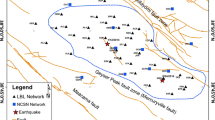Abstract
An attempted use of seismic gap observations to predict a large earthquake in Oaxaca, Mexico is discussed. The observations were initially published in a scientific journal and were subsequently distorted by noncientists, who predicted a major earthquake and tsunami to take place at Pinotepa Nacional, Oaxaca on 23 April 1978. Public reactions and property losess sustained by individuals and communities were comparable to those expected from an actual earthquake. A revision of epicenter locations from the NOAA data file revealed that a number of earthquakes did occur in the alleged gap but had been excluded because their reported focal depth was in excess of 60 km. It is shown that the probability that the number of earthquakes in two consecutive time intervals of a stationary Poisson process differs by an amount which would be reported as a ‘seismic gap’ is of the order of 5% or more for Oaxaca. This means that spurious ‘seismic gaps’ would be observed in one out of 20 data runs. The possibility of detecting a true interval of abnormal quiescence in a random earthquake sequence appears to be fairly remote in this case.
Similar content being viewed by others
Reference
Ohtake, M., Matumoto, T. andLatham, G. V. (1977),Seismicity gap near Oaxaca, Southern Mexico as a probable precursor to a large earthquake, Pure and Appl. Geoph.115, 375–385.
Rights and permissions
About this article
Cite this article
Garza, T., Lomnitz, C. The Oaxaca gap: A case history. PAGEOPH 117, 1187–1194 (1979). https://doi.org/10.1007/BF00876214
Received:
Issue Date:
DOI: https://doi.org/10.1007/BF00876214




